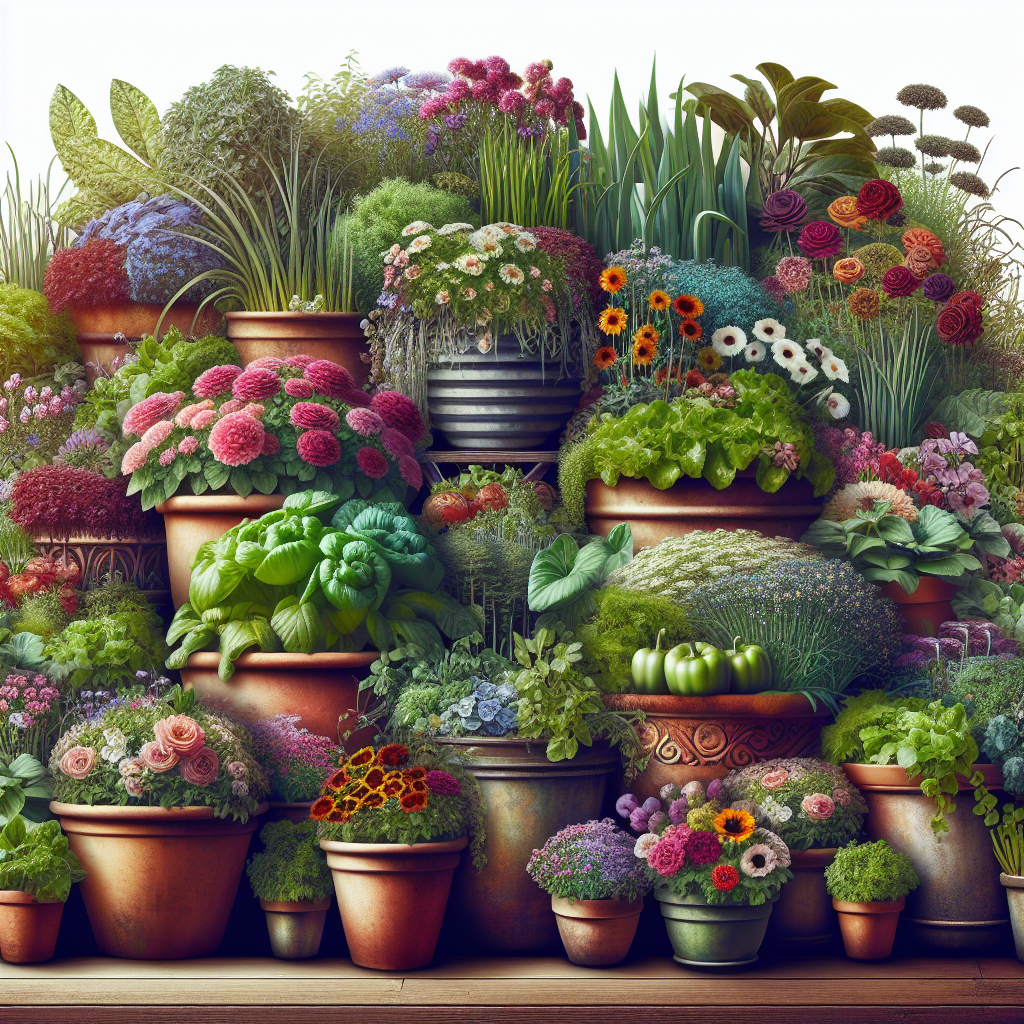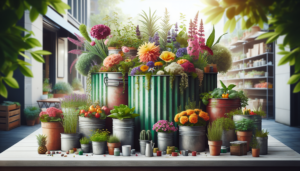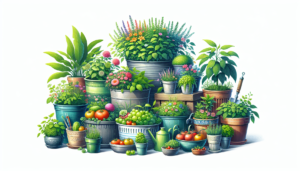
Imagine transforming your outdoor space into a vibrant oasis filled with blooming flowers, fresh herbs, and luscious vegetables. In “The Ultimate Guide to Container Gardening in the Northeast,” you will discover practical tips and expert advice on how to create a stunning container garden specifically designed for the unique climate and conditions of the Northeast. From choosing the perfect containers to selecting the ideal plants that thrive in this region, this comprehensive guide will empower you to create an enchanting and bountiful urban garden right outside your doorstep. Whether you are a seasoned gardener or a beginner, get ready to unlock the secrets to successful container gardening in the Northeast.
Selecting Containers
Choosing the Right Size
When selecting containers for your container garden in the Northeast, it’s essential to choose the right size that suits the needs of your plants. Larger containers generally provide better insulation for the roots against the cold temperatures that Northeast winters can bring. Additionally, larger containers retain moisture better, reducing the frequency of watering.
Considering Drainage
Proper drainage is crucial for the health of your container plants. Without proper drainage, excess water can accumulate around the roots, leading to root rot and other problems. Look for containers with drainage holes or consider adding drainage holes to the bottom if they’re missing. Elevating the containers on bricks or pot feet can also help facilitate better drainage.
Evaluating Material Options
There are various materials available for container gardening, each with its own advantages and considerations. Common materials include clay, terracotta, plastic, metal, and wood. Clay and terracotta containers are porous, allowing air and water to pass through, but they can be more susceptible to cracking in freezing temperatures. Plastic containers are lightweight and durable, but they may not provide as much insulation. Metal containers can heat up quickly in direct sunlight. Wooden containers can provide excellent insulation, but they require regular maintenance to prevent rot.
Selecting Plants
Choosing Cold-Hardy Varieties
In the Northeast, where the winters can be harsh, it’s important to select plants that can withstand cold temperatures. Consider choosing cold-hardy varieties of flowers, vegetables, and herbs that are adapted to the region’s climate. Look for plants that are labeled as appropriate for your USDA Hardiness Zone, which takes into account the average minimum temperature in your area.
Considering Sunlight Requirements
Different plants have varying sunlight requirements, so it’s crucial to consider the amount of sunlight your chosen plants need and the placement of your containers. Some plants, such as tomatoes and peppers, require full sun, while others, like ferns, thrive in shady conditions. Observe your outdoor space at different times of the day to determine the sunniest and shadiest spots and select plants accordingly.
Assessing Soil Preferences
Understanding the soil preferences of your chosen plants is essential for their success in container gardening. Some plants, like cacti and succulents, prefer well-draining soil with low moisture retention, while others, like bog-loving plants, thrive in wetter environments. Research the specific soil requirements of each plant and choose a potting mix that provides the appropriate conditions.
Preparing Containers
Cleaning and Sterilizing Containers
Before planting, it’s crucial to clean and sterilize your containers to reduce the risk of diseases or pests. Use a solution of one part bleach to nine parts water or a mild dish soap to scrub the containers thoroughly. Rinse them well and allow them to dry completely before adding any soil or plants.
Creating Adequate Drainage
To ensure proper drainage, it’s important to create drainage holes if your containers don’t have them already. Use a drill or a hammer and nail to make several small holes in the bottom of the container. You can also add a layer of rocks, gravel, or broken pottery shards at the bottom to prevent soil from clogging the drainage holes.
Choosing the Right Potting Mix
Selecting the appropriate potting mix is crucial for the success of your container garden. Look for a high-quality potting mix specifically formulated for container gardening. These mixes typically contain a blend of organic matter, perlite, vermiculite, or other materials that provide good drainage and moisture retention. Avoid using regular garden soil, as it can become compacted and hinder root growth.
Container Placement
Identifying Microclimates
In container gardening, microclimates play a significant role in the success of your plants. Different areas of your outdoor space can have slightly different climates due to variations in sunlight exposure, wind patterns, and nearby structures. Observe these microclimates and choose the appropriate plants for each area. For example, a sheltered spot near a brick wall might provide more warmth, making it suitable for frost-sensitive plants.
Optimizing Sun Exposure
Proper sunlight exposure is crucial for the growth and development of your container plants. The amount of sunlight required varies between plants, so consider their individual needs. Place sun-loving plants in areas that receive full sun for most of the day, while shade-loving plants should be placed in areas that receive partial shade or filtered sunlight. Keep in mind that the position of the sun changes throughout the year, so monitor the sun exposure of your containers regularly.
Considering Wind Factors
The Northeast can be prone to strong winds, especially during winter storms. When selecting the placement of your containers, consider the wind patterns in your area. Choose locations that offer some protection, such as against a wall, a fence, or under the canopy of a sturdy tree. Protecting your containers from strong winds will prevent plants from drying out and suffering damage.
Watering Techniques
Determining Water Needs
Proper watering is essential for the health and vitality of your container plants. The water needs of plants can vary, so it’s important to determine the specific requirements of each plant. Factors such as the plant’s water retention capacity, potting mix, and environmental conditions influence how often and how much water it needs. Research the water needs of your chosen plants and adjust your watering schedule accordingly.
Monitoring Soil Moisture
Regularly monitoring the moisture level of your container soil is crucial to ensure your plants receive the right amount of water. Stick your finger about an inch into the soil and check if it feels dry. If it does, it’s time to water. Avoid overwatering, as it can lead to root rot. On the other hand, underwatering can cause stress and hinder plant growth. Finding the right balance is key.
Choosing the Right Watering Method
There are various watering methods to choose from, including hand watering, using a watering can, or utilizing drip irrigation systems. Hand watering can be precise and allows you to tailor the amount of water each plant receives. Using a watering can is convenient for container gardens with multiple plants. Drip irrigation systems help ensure consistent moisture by delivering water directly to the roots. Choose the method that best suits your gardening style and needs.
Fertilizing and Nutrient Management
Understanding Nutritional Requirements
Container plants rely on you for essential nutrients, as the limited soil volume restricts their access to natural nutrient sources. Understanding the nutritional requirements of your plants is crucial for their growth and productivity. Research the specific needs of each plant, including the essential macronutrients (nitrogen, phosphorus, and potassium) and micronutrients, and choose a fertilizer that provides the necessary nutrients in the correct proportions.
Choosing Fertilizer Types
There are various fertilizer types available, including organic and synthetic options. Organic fertilizers are derived from natural sources and release nutrients slowly over time. They improve soil fertility and encourage beneficial microbial activity. Synthetic fertilizers, on the other hand, are chemically formulated and release nutrients quickly. They can provide a rapid nutrient boost but should be used with caution to avoid over-fertilization.
Applying Fertilizer Effectively
Proper application of fertilizer is crucial to avoid nutrient imbalances and potential harm to your plants. Follow the instructions provided by the fertilizer manufacturer regarding the application rate and frequency. Remember that over-fertilizing can lead to nutrient burn and damage plants. Consider using a liquid fertilizer diluted in water for container plants, as it ensures even distribution and reduces the risk of burning.
Pest and Disease Management
Identifying Common Pests
Pests can be a common challenge in container gardening, but with proper identification, you can effectively manage them. Keep an eye out for common pests such as aphids, spider mites, whiteflies, and slugs. Regularly inspect your plants for any signs of pest infestation, such as distorted growth, holes in leaves, or sticky residue. Identifying the pests early allows for prompt intervention to prevent further damage.
Preventing Diseases
Diseases can affect plants in containers, especially when conditions favor their development. Preventive measures can help minimize the risk of diseases. Ensure proper sanitation by removing dead plant material and fallen leaves regularly. Avoid overwatering, as it contributes to the development of fungal diseases. Provide adequate airflow around your containers to reduce humidity levels and discourage disease development.
Implementing Organic Pest Control
Consider implementing organic pest control methods to manage pests in your container garden. Introduce beneficial insects such as ladybugs or lacewings, which prey on common pests. Use organic sprays or soaps, like neem oil or insecticidal soap, to target specific pests. Encourage biodiversity by planting flowers that attract pollinators and beneficial insects, creating an ecosystem that naturally regulates pest populations.
Companion Planting
Exploring Companion Planting Benefits
Companion planting involves strategically planting different plants together to benefit one another. It can help repel pests, attract beneficial insects, improve pollination, and maximize space utilization. Research companion planting combinations that work well in container gardens. For example, planting marigolds alongside tomatoes can help repel pests that commonly affect tomatoes.
Identifying Compatible Plant Combinations
Identify compatible plant combinations by considering their growth habits, nutrient requirements, and pest and disease resistance. Some plants, like basil and tomatoes, complement each other well, while others, like beans and onions, can compete for resources. Consider planting taller plants at the back of containers to avoid shading smaller plants and ensure everyone receives adequate sunlight.
Avoiding Negative Interactions
While companion planting can be beneficial, it’s important to be aware of negative interactions between certain plants. For example, planting mint near other plants can inhibit their growth due to its aggressive spreading habit. Research the plants you intend to companion plant to ensure they are compatible and avoid any potential negative interactions.
Seasonal Care
Spring Preparation
In the Northeast, spring is a crucial time to prepare your container garden for the growing season. Inspect and clean your containers, removing any debris or plant material that may harbor pests or diseases. Check for drainage issues and fix any problems. Refresh the potting mix if needed. Start sowing seeds or transplanting seedlings of cold-hardy plants that can withstand potential frosts. Provide protection against late spring frosts, such as using frost blankets or moving containers indoors overnight.
Summer Maintenance
During the summer months, container plants require regular care and maintenance. Check the moisture levels of the soil frequently and water as needed, especially during hot and dry periods. Monitor your plants for pest infestations or signs of disease, and take appropriate action promptly. Pinch back any leggy or overgrown growth to maintain bushier and more compact plants. Harvest ripe fruits, vegetables, or herbs to promote continuous production.
Fall/Winter Considerations
As fall approaches in the Northeast, it’s essential to consider the impact of colder temperatures on your container garden. Evaluate the life cycle of your plants and decide whether they will continue growing or if it’s time to prepare for winter. Start transitioning cold-sensitive plants indoors or provide them with a protective cover, such as a cold frame or frost cloth, to prolong their growing season. Clean and sanitize your containers before storing them for the winter.
Overwintering Containers
Choosing Suitable Overwintering Plants
For those in the Northeast who wish to continue container gardening through the winter, selecting suitable overwintering plants is crucial. Look for cold-hardy plants that can tolerate freezing temperatures and provide color or interest during the winter months. Evergreen plants, such as ornamental grasses or hollies, can provide year-round structure and visual appeal.
Insulating Containers
During the winter, it’s important to insulate your containers to protect the roots of your overwintering plants from extreme cold temperatures. Wrap the containers with insulating materials, such as burlap or bubble wrap, and secure them with twine or tape. This insulation helps maintain a more consistent soil temperature and prevents freezing damage.
Providing Adequate Shelter
In addition to insulation, providing adequate shelter for your containers during the winter months is important. Move your containers to protected areas, such as against a south-facing wall or under the eaves of a building. This can provide additional warmth and shield them from harsh winds. Consider using windbreaks or constructing simple structures, like wooden frames with plastic sheeting, to create a mini greenhouse effect and protect your plants.
By following these comprehensive guidelines for container gardening in the Northeast, you’ll be equipped to successfully cultivate a beautiful and productive garden. Whether you’re a beginner or an experienced gardener, container gardening offers a flexible and rewarding way to enjoy plants and greenery, even in limited spaces. So gather your containers, select your plants, and embark on an exciting journey of container gardening in the Northeast!







